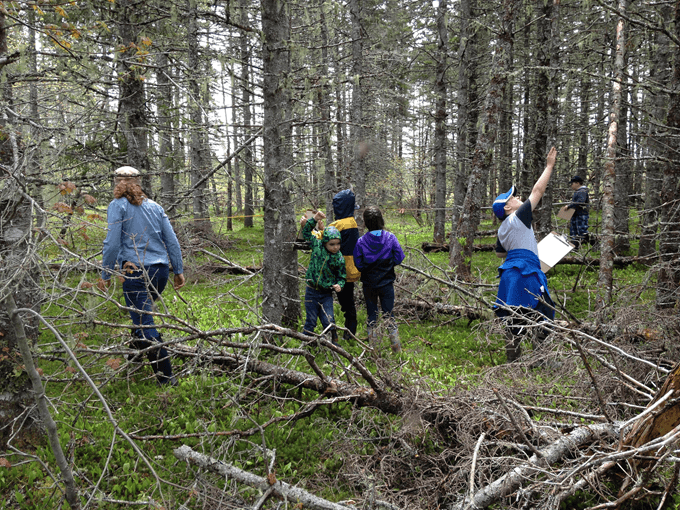Forest Watch

Our forest monitoring project, Forest Watch, was started in 2017 when the Forest Watch committee piloted some educational activities in a local school (Middle River Elementary). A small woodlot adjoining the school provided the perfect location to discuss forest ecology and get the students into the woods. In early June, 2017, we identified trees, shrubs, and animals found in and around the woodlot. The main focus was to give elementary students an insight into inventorying a forest stand. We introduced the concept that a tree, like any living thing, has a lifespan. We looked for living creatures on both live and dead trees to help teach them that these living and dead trees are all part of animal habitat.
Also in June, 2017, the Forest Watch volunteers established a connection with the Mersey Tobeatic Research Institute, located in the other Nova Scotian UNESCO Biosphere Region (Southwest Nova). Their experienced staff trained the Bras d’Or Biosphere volunteers in methods to be used for forest monitoring in our Biosphere.
In September 2017, we returned to Middle River Elementary to review forest species and look for living things found within the woodlot in the fall season. We also began a program with the high school at Potlotek First Nation. The first site visit with those students happened during the following spring. These schools will be revisited and the program expanded to other schools in the Biosphere. We will help students train their eyes, ears and other senses on the forest…to develop the tools to understand what Mother Earth is telling us.
Our forest committee is expanding its’ horizons to post-secondary International students. In early November 2017, the Forestry Committee of the Bras d’Or Lake Biosphere Region Association played host to 35 International Students from the Coady Institute of St. Francis Xavier University. Students were given a tour of a private woodlot in Johnstown highlighting restoration work that is being done there. The students enjoyed learning about old growth forests but were equally as curious about the operations within the context of a UNESCO Biosphere.
Forest Watch Committee Website Update – July 2021
The Forest Watch Committee is focused on providing opportunities for education and experiences, that give individuals a better understanding and appreciation of all forest values, including ecological, recreational, and economical. Since the committee’s inception early in the history of this Biosphere being designated, the committee has offered a wide range of opportunities within schools and communities. For a few years, there were great educational projects at the high school in Potlotek First Nation and the Middle River Elementary School, amongst many other initiatives; however, some of these had to be paused during the pandemic and are taking on new forms as we navigate the changes. The Forest Watch Committee continues to engage students in educational projects, and most recently, in collaboration with the Department of Lands and Forestry, had NSCC students participating in soil surveys and tree planting to restore an old mine site in Irish Cove. The growth of this site will be measured and monitored, and a picnic shelter will be installed, providing an opportunity for community members to learn about the restoration project and enjoy the area.
Another way for anyone in the Biosphere to get involved, whether resident or visiting, is by participating in the Citizen Science initiatives currently being promoted by the Forest Watch Committee. The iNaturalist app downloaded on a device, allows anyone to upload a picture of flora or fauna sighted in the Biosphere, which is then verified by scientists and added to a giant database to give an accurate picture of the biodiversity of the area. Citizen Science initiatives requiring a longer-term commitment include stream and groundwater monitoring where conductivity, temperature, pH, and turbidity are measured on a regular basis. Furthermore, interested citizens can learn how to collect data from the Mesonet sites installed all around Cape Breton to monitor weather.
In collaboration with Explore the Bras D’Or and the Trails Committee, the Forest Watch is offering two semi-guided hiking opportunities in July and August where participants can learn more about unique forest ecosystems in the Biosphere. Throughout the year, the committee plans to add signage to the existing trails to provide information and interaction with the environment, and to encourage people to continue enjoying the incredible Bras D’Or Lake Biosphere all year long!
